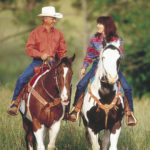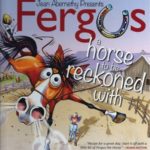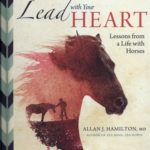I really wouldn’t want to train me. It would be too frustrating. It isn’t that I can’t ride well, but often I do not. I was a regional champion in the 1996 Ariat National Medal competition; overall, though, the show-ring success I’ve enjoyed has been sporadic, thanks to that irksome little interference called work, plus a few detours resulting from equine unsoundness. And then there’s my mental makeup: I can be anxious, fearful, nervous, and perfection-driven, trying so hard and thinking about so much that I “black out” while on course.
My riding is, in a nutshell, consistently inconsistent, with moments ranging from brilliant to embarrassing. I understand some of the reasons. Buckshot, a pony I owned as a six-year-old, delighted in running away with me while he was bucking; so did Henry Higgins, mine when I was sixteen. After a few memorable accidents with him, I didn’t ride again until I was thirty-seven. I’m forty-eight now, competing–when I can–in the adult-amateur jumpers.
A Promising Program
As I thumbed through a catalogue of riding vacations a write-up on a training program in Ireland caught my eye. The week-long session with Sue and Dan Foley at Clonshire Equestrian Centre in Adare, County Limerick, sounded intriguing: “Sue and Dan believe strongly that riding in a ring is just not enough to develop a capable and stylish rider.” I couldn’t agree more.
For years, many of the riding demons I faced had surfaced whenever I left the confinement of the ring; images of being run away with, bucks included, would crowd in to haunt me. This trip, I calculated, could be just the cure. After all, the Irish are renowned for their “push-button” horses and their affinity for the horse in general. Could I put my faith in a pair of strange trainers and their horses and emerge unscathed–even, ideally, “new and improved”? I did. Here’s how.
“Ride Forward”
Sue and Dan manage a 120-acre facility with seventy horses, adeptly matching all levels of riders–from never-ever to Grand Prix or Advanced–with the appropriate mount. (They also oversee a strong sales business in Irish Sporthorses: three quarters Irish Thoroughbred, one quarter Irish Draught.)
Sue’s infectious smile and endlessly positive attitude, combined with Dan’s wit and no-nonsense approach to teaching, make for a perfect team. Her resume includes certification as a British Horse Society instructor and a winning record in eventing and show-jumping; his includes the enviable ability to ride absolutely anything over anything. (A typical “Dan-icism”: “Confidence is a funny thing. When you have it, you don’t even know you have it; but when you don’t have it, you miss it terribly!”) Nothing makes him happier than to match wits and patience with a temperamental young horse one day and have the same youngster working quietly, calmly, and happily the next.
A Clonshire vacation consists of five days of serious riding, three to four hours per day. Each day starts with an hour of work on the flat, followed by work over jumps in the arena-all with the two-word credo “Ride forward.” Dainty American equitation positions, as Sue told me, are not practical for either the type of horse or the work to be done in Ireland. “To ride a Thoroughbred horse in two-point is fine, but the Irish horse needs you to sit up and back and keep a lot more leg on, pushing him forward into the hand.” She also likes Americans to maintain a strong rein contact. (Being used to cantering quietly to my equitation fences, I found following her advice a struggle.)
Arena Work
Even daily ring warm-ups emphasized a strong, active canter. One very effective basic exercise consisted of jumping a vertical to a pole placed one, then two, then three, four, five, and finally six strides away. Explained Sue, “It’s easier to make the distance with the pole closer to the first jump, but the test here is to maintain that very forward momentum to the pole as we increase the number of strides. The farther we move the pole, the more it tests your eye.” After we mastered the six, an oxer replaced the pole.

One of Dan’s favorite warm-ups started with a tight turn to a six-stride line on the diagonal. He wanted us cantering very forward out of the corner to a vertical, then briskly down six strides to an oxer. As we grasped that, he added two more fences on the other diagonal for a figure-eight pattern. My athletic and intelligent mount, Augustus, preferred to gallop around the end of the ring and cut the turn, which left us meeting the first jump on a slight angle and Augustus “falling in.” Inevitably, we’d chip to the jump, land, and have to go very forward to make up the distance down the line to the second fence.
To correct the problem, Sue instructed me to push from my inside leg into the outside rein on the end of the ring and the turn, asking Augustus to soften and bend, and also to be careful not to drop my shoulder. This was a real test of “seeing the correct spot.”
Dan presented a rationale for the exercise: “When you ride a horse with a lot of scope, he can go up the six-stride distance in a seven and make it easily over the jump. But as the fences get higher and he finally reaches his level of jump, he must go in six to maintain the momentum and power to clear the fence. That’s why you want to jump the line in the correct number of strides now.”
Riding a “Course”
Arena work on our fifth and final day included a technical show-jumping course set at 3 feet 3 to 3-6. It started with a wide oxer, down four strides to a vertical, then a gentle right turn to a skinny vertical and continuing right to an oxer-to-vertical in-and-out, a sharp right downhill to another skinny vertical, lead change left to a formidable gate-to-oxer in three strides, ending uphill to an oxer. The toughest part of the course? The first oxer, of course–which we had to meet at a near-gallop.
After my typical “Where am I?” bobble on our first start, Augustus and I began again. This time we nailed the course with ease. (In a show, though, I knew, there’d be no such second chances.)
Confronting Cross-Country
But cross-country was what I’d come to master. We worked on that, too, from day one–and it was there that my fears really surfaced. For someone used to riding only in a flat arena with footing that’s prepped daily, the experience of being “out” at Clonshire raises many “what-ifs.” First, there is the sheer vastness of the acreage–and no fencing. The footing isn’t level, there’s mud, and there are holes–some almost 6 inches deep–and plenty of hills from gentle to steep. The jumps include solid verticals, ditches, grobs, water, banks, and stone walls–real ones, typical of the Irish landscape and used to divide property lines.
Then there’s the weather. The Emerald Isle is “emerald” because so much rain nourishes its lush vegetation. At Clonshire, you ride stadium or cross-country in the rain if you want to ride and there’s precipitation.
All these intimidating factors kept my mental wheels spinning-but this was, after all, what I knew I must deal with, so I confessed my hesitations right up front. That let Sue and Dan know what kind of work lay ahead. Our first day out, with Sue leading and with me on Whiz Kid, we toured the entire farm and jumped some small obstacles along the way. (“The first day, we want people to get used to the size of the place and used to attacking the fences a little bit,” she said.) First was a small vertical and a sharp right turn around a tree, then up an 18-inch bank; the horse stopped and waited for his next direction. (Self-talk: No, Steph, he’s not running away with you-is he?)

We meandered over some 2-foot-9-inch walls and some verticals set between trees, and came to our first water jump: a 3-foot drop into a creek, with the option of jumping a 2-6 vertical on the way out. “Thanks, but no thanks,” I said, choosing the path of least mental resistance.
Dan led the second day’s cross-country; this time I was back on Augustus, whom Dan characterized as “a horse who is better if he can’t think too much.” No sooner would Dan direct me to jump a fence than Augustus would turn to start his galloping approach.
Dan led me up and over a 3-foot bank and told me to keep galloping. I was clenching the mane so tightly I could have pulled it out as we continued over a 3-foot vertical to–tell me it’s not true–a 3-6 to 3-9 point-to-point brush fence. I knew we were going fast because the wind was whistling in my ears.
After a breather, it was on to a vertical in the woods and five strides to a 4-foot-wide ditch (or “coffin,” as we appropriately call them in the States). The path included a determined gallop to an in-and-out: a 3-foot wall, then a bounce to a huge tree trunk, with no way out but over. On the other side, I was shaking-but pleased as punch to have emerged, grinning like a Cheshire cat. Tackling more walls and verticals at intermittent spots, we finished the course with a wall to two tree trunks–two strides–to a triple combination to a tire jump. And as we finished, with me still in the saddle, I was beaming. I can do this. No, I am doing this!
Still Learning
Even though Augustus was extremely brave, smart, and always planning ahead, several times he sensed my obvious hesitancy and actually declined to jump. I was also “niggling,” to coin Dan’s term: messing with the reins pre-takeoff, an old habit that (regrettably) hasn’t died hard-or any other way. (Steph, most of your past successes came when you followed your trainer’s command to simply “do nothing,” remember? Yeah–but easier said than done when you’re a Type A+.) Darn, I thought. I’m doing just exactly what I don’t want to do.
Augustus was very forgiving, however; and with Dan’s encouragement, on day three I galloped in no uncertain terms to every fence that had given me pause on day two, with no question about whether we were going to jump it! “There are two things a rider can control: pace and direction. The rest is just going to happen. You, Steph, get frustrated because you can’t control everything.” (Did I mention Dan is also a psychologist? Or does riding just echo life?)
Each day we repeated the long courses, adding more fences and working on longer approaches at the gallop. I even learned to jump down, something that’s always intimidated me. (A tentative child, I never rode Ferris wheels or roller coasters. On an amusement ride or a horse going downhill, my stomach had always ended up somewhere in my head.) “Look straight ahead, not down,” Dan coached at the water jump. I also jumped down a couple of walls I’d earlier been so proud just to have jumped going up.
The pi’ece de resistance was mastery of a bank jump that would be rated Preliminary Level in the United States: jumping one stride over a small ditch, one stride up a steep incline, and then straight down 3 feet 6 or so to level ground. I jumped it in both directions!
After the strenuous morning rides, Sue and Dan filled our afternoons with hacks around the property or to adjoining estates. Now we were really “riding out”–and my overactive mind started wondering, “Isn’t the horse going to spook at those (fill in the blank: houses, kids, dogs, garbage cans, cars)?” We actually trotted on the curving, paved roads; no, it doesn’t hurt the horses’ feet, and yes, drivers in rural Ireland are quite used to giving way to equine parades. And no, the horses didn’t spook.
Getting What I Came For
I worked so hard on my riding at Clonshire that only when I returned home was I able to reflect on my accomplishments. I recalled the squeals of glee from one of my fellow guests, riding cross-country with me, as he and his horse leaped down into the water. “Yes!” he shouted happily. “THIS is what I came here for!” Me, too, come to think of it. I came; I rode; I conquered. I even left with a red ribbon presented by Dan and Sue (red is first place in Europe). Better yet, I came away with confidence that I couldn’t have attained anywhere else in such a short time.
For more information, go to www.clonshire.com.
Based in Sherman Oaks, Calif., Stephanie Stephens is an equestrian print/broadcast journalist who also does voiceovers and commercials.








